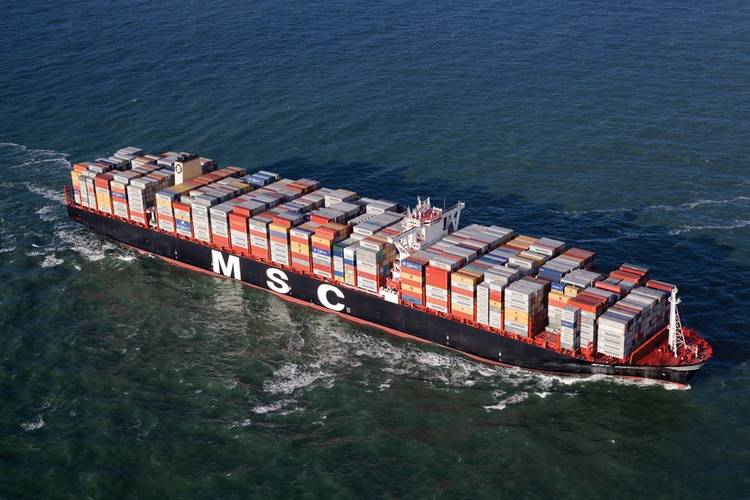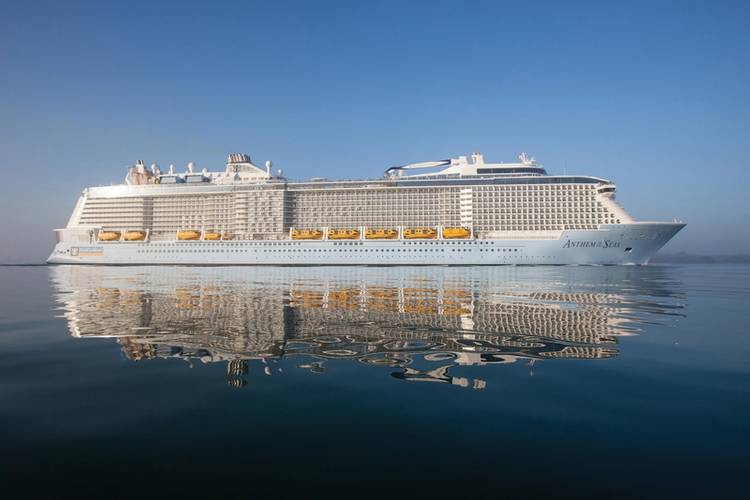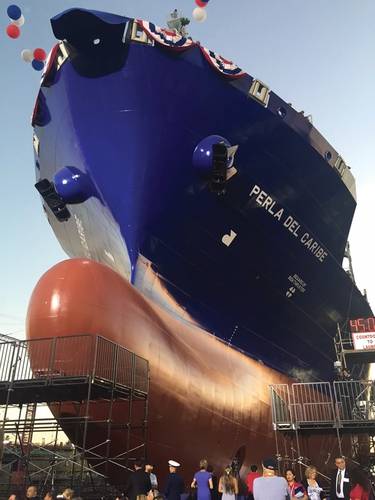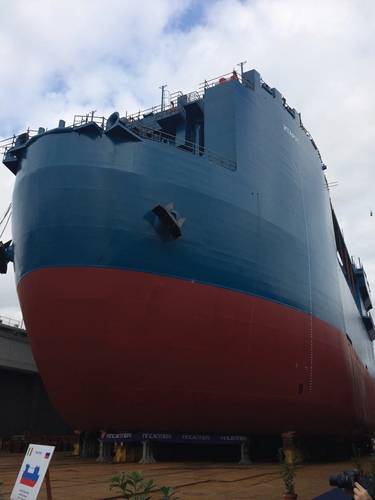Maritime innovation never stops, and 2015 was certainly no exception, as a number of “world firsts” hit the high seas. In its December 2015 edition Maritime Reporter & Engineering News (http://digitalmagazines.marinelink.com/nwm/MaritimeReporter/201512/) presented its “Great Ships of 2015;” MarineLink.com takes the process one step further, and here confer the “Top Five Ships” of 2015.
The Ship:
Anthem of the Seas
The Skinny:
The World’s Smartest Cruise Ship
The Specifics:
With a gross tonnage of 168,666, somewhat smaller than the world's largest Oasis class vessels, Royal Caribbean Cruises Ltd. (RCCL) took delivery of the first vessel in its new class of vessels, the Quantum of the Seas in 2014 and Anthem of the Seas in April 2015. The third vessel, Ovation of the Seas, is to be delivered from the Meyer Werft in Germany in spring 2016, with which a fourth vessel was ordered in May. These huge cruise ships are designed and equipped with the latest available technologies, both for the 'hotel side' of the vessel as also technically, in order to provide a safe, clean, efficient and fuel saving ride for its 4,180 passengers – the world's smartest cruise ships', according to EVP Harri Kulovaara.
These cruise ships are fitted with ABB's latest electrical 20.5MW pod drives of the Azipod XO type. The two pods are powered by four Wärtsilä medium speed diesel-generators providing a total power of 67,200kW. There are four tunnel thrusters forward. The vessel is fitted with a smart onboard advisory and decision support system, by Eniram with automation by Metso, and with Napa's flooding decision-making solution. An advanced safety centre is placed behind the L-3 Systems' Nacos bridge. Both safety and energy efficiency is improved, and operational data is also sent ashore. Further energy is saved by advanced air conditioning, and by applying a micro-bubble system where air is blown underneath the hull to reduce water resistance.
The vessel has 16 passenger decks, 2,090 staterooms of which 1,570 with balconies. The inside staterooms are fitted with a 'Virtual Balcony', a wall-size TV screen showing the view outside. There are 19 eating places onboard, a large theater forward and the pool area with fitness center on the decks highest up. The 'NorthStar' glass-walled observation capsule, attached at the end of a 41m crane arm, lifts up to 14 guests. The supplier of this gadget is MacGregor. Among the many amenities onboard is also the 'SeaPlex' multifunctional gym, or basket court, or dance hall, located on deck 15.
Anthem of the Seas is now sailing from Cape Liberty, New Jersey.
The Ship(s):
Isla Bella & Perla Del Caribe
The Skinny
These innovative sisterships, built by General Dynamics NASSCO for TOTE, are the World’s First LNG Fueled Containerships.
The Specifics:
Shipbuilding history was made in 2015 when NASSCO delivered Isla Bella and launched Perla del Caribe for TOTE, the culmination of one of the most exciting and anticipated newbuild programs in U.S. shipbuilding history, the world’s first LNG fueled containerships.
The Perla del Caribe and her sister ship, christened Isla Bella, were purpose-built for the Puerto Rican trade for TOTE Shipholdings and will be operated by TOTE subsidiary Sea Star Line out of Jacksonville, Fla. In moving to natural gas, the Marlins will reduce NOx emissions by 98 percent, SOx by 97 percent, carbon dioxide by 72 and particulate matter by 60 percent over the Ponce Class ships - the company’s vessels currently serving the trade.
“TOTE is one of six lines of business that together create a national transportation network, moving cargo by land, sea and air,” said Tim Engle, President of Saltchuk, TOTE’s parent company at the launch ceremony of Perla del Caribe.
"The Marlin Class ships are the most fuel efficient, eco-friendly containerships in the world. As the first of their kind, these ships represent the next generation of US-built ships and we at General Dynamics NASSCO are proud to be leading in that effort," said Fred Harris, president of General Dynamics NASSCO.
The Perla del Caribe will enter service in the first quarter of 2016 between Jacksonville, Florida and San Juan, Puerto Rico. Isla Bella, the first Marlin Class vessel, launched in April of 2015 and will enter service later this year.
The Ship
MSC Oscar
The Skinny:
The World’s Largest Containership (for the moment!)
The Specifics:
MSC Oscar, delivered in January this year, is the first in a new series of world's currently largest container ships ordered by (MSC) Mediterranean Shipping Company from Daewoo Shipbuilding & Marine Engineering (DSME) in South Korea. Followed by MSC Oliver in March, MSC Zoe in August, and MSC Maya in September, the vessels are part of a huge 20 vessel charter agreement aimed at boosting global container shipping efficiency as well as the competitive position of MSC, the world's second biggest operator. Capable of carrying 19,224 TEU (954 more than the 18,270 TEU of Maersk's Tripple-E) the vessels measure slightly under 400m in length and are 59m wide. The price tag is above USD140m. The container capacity was raised from the initial 18,400 TEU through supplementing it with additional tiers of containers on top, a design made possible by applying the classification company DNV GL's RSCS (Route Specific Container Stowage) class notation.
The superstructure is placed a third from the bow for good view. The fuel tanks are placed underneath to clear adjacent areas for container cargo. The single main engine is a super long stroke MAN B&W 11S90ME-C (10.2) electronically controlled two-stroke diesel engine producing 62.5MW power. Different engine running modes can be selected automatically, based on operating conditions. According to the owner the 'MSC Oscar is the most energy efficient vessel on the planet consuming 35% less fuel and carbon dioxide'. The vessels uses a torsion box design of its U-shaped hull and hatch coamings, with steel plates up to 100mm thick. The size makes the Oscar-class among the first Post-New-Panamax vessels.
The Ship:
Ohio
The Skinny:
1st of 4 Jones Act Tanker from Aker Philadelphia; Product Tanker built to be “LNG Ready”
The Specifics:
Crowley Maritime took delivery of Ohio the first of four Jones Act product tankers from Aker Philadelphia Shipyard, Inc. (now called Philly Shipyard Inc.) earlier this year. The newbuild is significant as it signifies the first time a product tanker has been constructed with consideration for the future use of LNG for propulsion. The remaining three product tankers being built by APSI for Crowley are currently under construction and have planned deliveries through 2016.
“We are excited to offer our customers cutting-edge technology available in these new tankers, which not only embraces operational excellence and top safety, but also offers the potential to be powered by environmentally friendly LNG in the future,” said Crowley’s Rob Grune, SVP and general manager, petroleum and chemical transportation.
The new 50,000 dwt product tankers are based on a Hyundai Mipo Dockyards (HMD) design which incorporates numerous fuel efficiency features, flexible cargo capability, and the latest regulatory requirements. The vessel is 600 ft. long and is capable of carrying crude oil or refined petroleum products.
Crowley’s Seattle-based, naval architecture and marine engineering subsidiary Jensen Maritime provided construction management services for the product tankers.
The Ship: Itarus
The Skinny:
Semisubmersible Floating Platform to transport Nuclear Waste from Russian Navy
The Specifics:
New semisubmersible floating platform will be used to transport special material decommissioned by the Russian Navy Itarus, the new semisubmersible floating platform built to transport Russia’s nuclear materials, was launched at a ceremony on November 19 at Fincantieri’s shipyard in Muggiano, La Spezia.
Built by Fincantieri for the Russian RosRAO, the Federal State Unitary Enterprise for radioactive waste management, the vessel will be used for the transportation of nuclear submarine reactor compartments decommissioned by the Russian Navy from the storage area of Sayda Bay to the Nerpa Shipyard (and vice-versa), facing the Kola Peninsula in the Barents Sea.
Measuring just over 79 m long and about 29 m wide with a deadweight capacity of 3,000 metric tons, the vessel’s maximum draft is 24.5 m, achievable during the cargo docking, by means of 45 ballast tanks for a total capacity of 25,000 cu. m. of ballast water, fed by four pumps of 2,000 cu. m. per hour capacity. The vessel will be equipped with living areas, to host a crew of six on board.
Itarus was constructed in the Integrated Shipyard of Riva Trigoso and Muggiano with the support of the facility of Palermo, supervised by the Russian Maritime Register of Shipping.
The contract to build the unit was signed by the Italian Ministry of Economic Development, RosRAO (the Russian Federation national nuclear corporation) and Fincantieri in November 2013 during the Italy-Russia Business Forum in Trieste. It follows the 2003 cooperation agreement between the Russian and Italian government for the decommissioning of nuclear submarines and the safe management of radioactive waste and nuclear fuel, defined within the framework of the Global Partnership, started in the 2002 G8 summit in Canada.
Itarus’ godmother is Rosaria Fausta Romano, General Director of the Italian Ministry of Economic Development’s department for the electricity market, renewables and energy efficiency, nuclear. Other attendees at the launching ceremony included, among others, by Angelo Fusco, Fincantieri’s Senior Vice President Italy Naval Vessels Business Unit; as well as Oleg Kryukov, Rosatom’s Director for Public Policy on Radioactive Waste, Spent Nuclear Fuel and Nuclear Decommissioning.


















